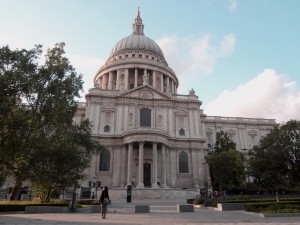About
On September 5, 1666 a fire started at a bakery on Pudding Lane. It gutted the medieval city of London inside the old Roman city walls. It threatened, but never reached the aristocratic city of Westminster. 13,200 homes were lost along with 87 parish churches including St. Paul’s Cathedral. It is estimated that 70,000 of the nearly 80,000 inhabitants of London lost their homes. Famed architect Sir Christopher Wren designed and rebuilt St. Paul’s Cathedral with a new design that would become his masterpiece. Wren’s cathedral was the fourth built on the property dating back to the 7th century and it was much different than the previous three. St. Paul’s Cathedral sits on Ludgate Hill, the highest point in London.
Location
St. Paul’s Cathedral was built in the original town of London which is located just east of Westminster. Both are north of the Thames River which flows mostly east and west through London.
My Experience
I made it to the Tube (London subway) after my last meeting of the day and wanted to get to St. Paul’s before they closed for visitors. On a previous day out to the Globe Theater, I had taken pictures of the outside of St. Paul’s. However, I knew it would be important to see the inside of the great cathedral. I wasn’t disappointed.

In the courtyard of St. Paul’s Cathedral, this marks the location of the “folkmoot” where people in London gathered to hear some of the greatest sermons, accusations and political statements announced to the people in England’s history.
The other great cathedral in London is Westminster Abbey. Its gothic architecture and ancient royal tombs are impressive. However, St. Paul’s is impressive in a different, more modern way. To me, it is the working man’s Westminster Abbey. There are no tombs of monarchs, but there are important military leaders buried in the Crypt. The two most important British military leaders of all time other than Winston Churchill, Lord Nelson and Duke Wellington, are buried in the Crypt of the Cathedral.
The line to purchase tickets was slow and it took longer than expected to get my mobile tour guide once in the cathedral. The church is massive, appearing the size of an airport hangar for a 777. There are plenty of interesting memorials on both sides of the Nave, but it becomes more impressive as you work your way to the Dome. The Dome is the center of activity for the cathedral. With large crowds of people around me, I sat under the Dome and became absorbed in my surroundings. The Dome is tall and much broader than I expected from the outside. It sits above the intersection of the Nave, Choir and Transept. It is a large open space made to help the worshiper experience the sounds and sights of heaven.
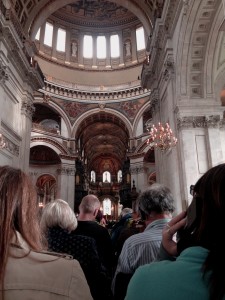
Pictures are taboo, but this was taken from my iPhone. I was sitting just inside the entrance listening to my mobile tour guide.
Like many UK cathedrals, there is a great deal of history – political, military and religious. The chapels are beautiful, but not really functional. The choir’s woodwork is intricate and detailed. Yet it was the Dome that interested me the most. I could see a circular balcony above me and knew I would want to experience that view.
I found the stairs on the side of the Nave and headed up. There is a guide at the door warning old people like me that there are almost 200 steps to the balcony. Even though I was in my dress shoes there was no way I was going to miss this opportunity. It was a wide, circular staircase, for a change, and the steps were short making the trek up the stairs easier. I was winded by the top of the stairs, less from the walk and more from the spectacular view of the Nave below.

Great artistic beauty is all around. This is part of the Dome. I took this picture sitting in the Transept.
The balcony is narrow with a concrete seat that runs the circumference. This area was named the “Whispering Gallery” by Christopher Wren, the architect. Two people are supposed to be able to sit opposite each other and one person should be able to hear the whispers across the gallery of the other. It was crowded on this level with lots of people resting or perhaps taking in the amazing sight. Several people were trying to see if they could whisper and be heard by a friend or family member on the opposite side. Perhaps it was too crowded or noisy, the young girl and her mother next to me were unsuccessful in their attempt.
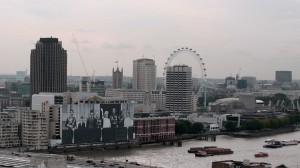
Picture taken from the lower external balcony atop of St. Paul’s Cathedral. The picture of the royal family was from the Diamond Jubilee ceremony in the summer.

To give some perspective on how high the lower balcony is, this is the clock tower of St. Paul’s Cathedral.
It was at the Whispering Gallery I discovered there is another 180 steps to a balcony which opens to the outside. It is a great view of London. My feet, back and legs hurt, but I knew I was going to the top. Taking a deep breath, I took off up the tight, winding staircase. Fortunately, there were “landing” or “resting” areas where there was room to sit and rest on the way up. I had company as I rested a couple of times, mostly by Baby Boomers. The pain was worth it as I stepped out onto the outside balcony. Unable to take pictures in the cathedral, I took out my camera and got some great photographs from the highest geographic point in London. The view was spectacular and the weather nice. I walked around the length of the balcony and took in the view while my legs rested. This is an excellent view of the Thames River and the historical buildings in Westminster.

This picture was taken from the upper balcony of St. Paul’s Cathedral. The Thames River runs through London.

This might give the viewer some perspective of the height difference between the two balconies. This is a picture of the clock tower that was taken from the higher of the two balconies.

After walking down, I sat outside the Cathedral and had some soft ice-cream. This picture was taken from the ground looking up at the highest balcony with a higher powered lens. Look close and the see the line of people walking around the balcony.
I discovered there was a last set of stairs leading to another external balcony near the very top of the dome. No way was I going to stop this close to the top, but I found myself frustrated with the architect who somehow thought this was a good idea. The last stairs were the worst. Metal stairs had been installed and they were steep. There was a busload of 200 German students who were behind me, passing me by like I was standing there. As I reached the top, sweating and panting, the line out the door was backed up. The students, awe struck with the view, were standing on the small circular balcony. It took a while for the line to move, but I was thankful for the rest! The view was spectacular. Similar to the view from the balcony just below, yet I felt a sense of accomplishment in reaching the very top.

This was the only walkway where the original stone steps were not used. It was pretty steep. I was pretty tired by this time.
London has a large number of German visitors. These students were polite and spoke decent English. I wondered to myself what they think when they see the view of London from St. Paul’s Cathedral. Just a generation ago the Germans tried to destroy London. The destruction and death was incomprehensible. Do they feel guilt or dismay at their ancestors? I look out across the city and realize they probably felt neither. The day is beautiful, the view is spectacular and they are enjoying London. Sometimes it is good that we have short memories.
I expected the walk down the steps to be easy, but I guess the damage was done. The pain from my dress shoes worked its way up to my legs and into my lower back. The back pain would be severe enough that in two days I would have my first acupuncture treatment to relieve it. It was just another first in my trip to the UK.
The Background and History
The first St. Paul’s Cathedral was built in 604 AD. It was located in the heart of London which, at that time, was about one square mile. This was the first recorded St. Paul’s Cathedral, but as Sir Christopher Wren noted during the building of the current Cathedral, he found pottery, urns and vessels from “antiquity” indicating the site was used in pre-Roman times.
The first church burned down in 675 and was rebuilt 10 years later. The Vikings destroyed it in 962. A new church was then built in stone. Following another fire in 1087 the church was rebuilt again. The Normans, who had only recently conquered Britain, decided to make the longest and tallest Christian church in the world. Originally finished in 1240, the project was immediately expanded and the Cathedral was consecrated in 1300.

This is a picture of the original or “Old St. Paul’s that was burned in the Great Fire of London in 1666.
Old St. Paul’s, as this church became known, fell into disrepair over the centuries. In 1633, the church began a restoration project to restore it to its original beauty. In 1642, the English Civil War interrupted work on restoration of the most important classical building in the country. After the civil war and the execution of Charles I, the country became less respectful towards the established church. Churches throughout England fell into disrepair. Shockingly, St. Paul’s became a horse stable and its Nave became a marketplace. When the monarchy was restored in 1660, King Charles II threw out all of the traders and began to restore the church to its former state. By 1662, the choir was fitted for services while the remainder of the church was repaired. A royal commission was established to determine the state of the building. Christopher Wren was hired to complete the restoration. Before any work could begin, the Great Fire of 1666 swept through London and destroyed “Old St. Paul’s”. The fire burned for four days and nights. Miraculously only twenty people were killed.
King Charles I and the Lord Mayor formed a commission to rebuild London. Within 9 days of the fire, Christopher Wren had submitted a grand plan to rebuild the city. With thousands of people homeless, the masses were more concerned about building homes than a grand vision for a new city. Wren’s grand plan for the city never came to fruition.
Temporary repair was made to St. Paul’s Cathedral, but the structure was unsound. In 1668, Wren was asked to submit a new plan to rebuild St. Paul’s and it was accepted. Within a year, demolition the Old St. Paul’s began.
In 1675, work began on rebuilding the Cathedral. In 1711, it was finished making it the first English Cathedral to be completed during the lifetime of the original architect. Wren took an active role in the construction of the Cathedral visiting the site weekly, managing the accounts and hiring supervisors. There was enormous pressure to finish the Church quickly and the commissioning committee put pressure on Parliament to cut Wren’s salary in half until the building was finished. The choir was finished in 1697 while construction went on around it. Until Wren’s death at 91 Wren regularly returned to St. Paul’s to sit under the dome and reflect on the masterpiece of faith and imagination.
Architecture
Most UK cathedrals have similar architectural elements: the Nave, the Crypt, the Transept and the Choir. Each of these elements has unique characteristics depending on the architect. Wren’s masterpiece included all four elements and presented them in a way more magnificent than any other I have seen.

Picture was taken from Millennium Bridge across the Thames River. On one side is Shakespeare’s Globe Theater and the other St. Paul’s Cathedral. The bridge was built in 2000.
The word Nave comes from the Latin word “ship”, an image often used to represent the Christian church and to suggest the idea of a spiritual journey. The Nave is the location where most of the members gather and is usually located inside the front entrance. Most Naves have memorials and monuments along their outer walls of important politicians, clergy and military leaders. While Westminster Abbey is virtually a tomb for UK royalty, St. Paul’s has memorials for key non-royal leaders including Duke Wellington, the hero of the battle of Waterloo where Napoleon was defeated. There is also a memorial to General Charles Gordon who, during the reign of Queen Victoria, played an important military leadership role in the UK’s great global empire of the 1800′s.
St. Paul’s is built in the shape of a cross, with a large dome crowning the intersection of its arms. The three-dome structure is unique among English cathedrals. It is 365 feet high (111.3 meters) which makes it one of the largest cathedral domes in the world. It weighs approximately 65,000 tons. The altar under the dome is the focus where the Eucharist is celebrated each Sunday.

This picture is slightly blurred because I didn’t want my phone confiscated. It is a picture below the Dome taken from the Whispering Gallery.
A transept is the east-to-west, or middle section, of a cross and includes the choir (spelled Quire in most UK cathedrals). The north end of the Transept is the Chapel of Saints. The south end is home to the effigy of the great English poet John Donne that miraculously survived the Great Fire that burned the Old Cathedral. There is also a memorial to Admiral Lord Nelson who defeated the French and Spanish navies during the Napoleonic Wars.
The choir was the first part of the cathedral to be finished. The organ is the centerpiece of the choir built my renowned German organ builder Bernard Schmidt. The composer George Frederick Handel loved the organ, more than likely, because it was the only organ in Britain with pedals. It has been rebuilt several times, most recently in 2008.

There have been other Duke of Wellington’s, but there is still only one real Duke of Wellington, the British hero at Waterloo.
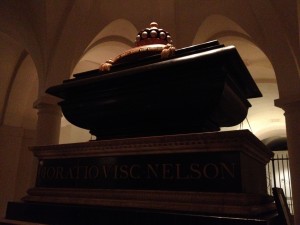
Tomb of Admiral Nelson, the hero of the battle of Trafalgar in which he led the British navy to victory over the French and Spanish navies. He died during the battle.
There are two famous tombs in the Crypt. Lord Nelson was killed in the Battle of Trafalgar in 1805 and buried in St. Paul’s after a state funeral. He was originally placed in a wooden coffin made from one of the ships he defeated in battle. Today his coffin is surrounded by a black marble sarcophagus originally made for Cardinal Wolsey. Lord Chancellor Wolsey was a favorite of Henry VIII who over time lost favor for his inability to get the Vatican to annul Henry’s marriage. The Crypt is also the home for the final resting place of Lord Wellington, known as the Iron Duke.
Ratings (Cathedral)
Category Rating: A
Overall Rating: #4
Comments: St. Paul’s is another “can’t miss” attraction in London. Although it lacks the history of Westminster Abbey, it is most spectacular. This Cathedral could never be fully appreciated without experiencing it firsthand.
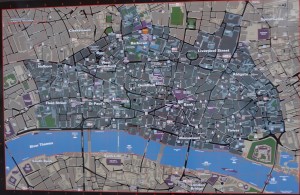
A picture of what was the original Londonium, or London. You can find St. Paul’s Cathedral on the map.







